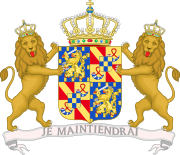
Back Prins van Oranje Afrikaans أمير أورانيا Arabic Прынц Аранскі Byelorussian Príncep d'Orange Catalan Tywysog Orange Welsh Fyrste af Oranien Danish Fürst von Orange German Πρίγκιπας της Οράγγης Greek Príncipe de Orange Spanish شاهزاده اورانژ Persian



Prince of Orange (or Princess of Orange if the holder is female) is a title associated with the sovereign Principality of Orange, in what is now southern France and subsequently held by the stadtholders of, and then the heirs apparent of, the Netherlands.
The title "Prince of Orange" was created in 1163 by the Emperor Frederick Barbarossa, by elevating the county of Orange to a principality, in order to bolster his support in that area in his conflict with the Papacy. The title and land passed to the French noble houses of Baux, in 1173, and of Chalons, in 1393, before arriving with Rene of Nassau in 1530. The principality then passed to a German-born nobleman from then Spanish Netherlands, Rene's cousin William (known as "the Silent"), in 1544. Subsequently William led a successful Dutch revolt against Spain, however with independence the new country became a decentralized republic rather than a unitary monarchy.
In 1702, after William the Silent's great-grandson William III of England died without children, a dispute arose between his cousins, Johan Willem Friso and Frederick I of Prussia. In 1713, under the Treaty of Utrecht[3] Frederick William I of Prussia ceded the Principality of Orange to King Louis XIV of France (while retaining the title as part of his dynastic titulature). In 1732, under the Treaty of Partition,[4] Friso's son, William IV agreed to share use of the title "Prince of Orange" (which had accumulated prestige in the Netherlands and throughout the Protestant world) with Frederick William.[5]
With the 19th century emergence of the Kingdom of the Netherlands, the title has been traditionally borne by the heir apparent of the Dutch monarch. Although originally only carried by men, since 1983 the title descends via absolute primogeniture, which means that the holder can be either Prince or Princess of Orange.
The current Dutch royal dynasty, the House of Orange-Nassau, is not the only family to claim the dynastical title. Rival claims to the title have been made by German emperors and kings of the House of Hohenzollern and by the head of the French noble family of Mailly. The current users of the title are Princess Catharina-Amalia of the Netherlands (Orange-Nassau), Georg Friedrich (of Hohenzollern), and Guy (of Mailly-Nesle).
- ^ Rietstap, Johannes Baptist (1861). Armorial général, contenant la description des armoiries des familles nobles et patriciennes de l'Europe: précédé d'un dictionnaire des termes du blason. G.B. van Goor. p. 746.
- ^ "Histoire de la ville d'Orange". Archived from the original on September 25, 2018. Retrieved May 5, 2011.
- ^ Harkness, D (April 1924). "The Opposition to the 8th and 9th Articles of the Commercial Treaty of Utrecht". The Scottish Historical Review. 21 (83): 219–226. JSTOR 25519665.
- ^ "Treaty between Prussia and Orange-Nassau, Berlin, 1732". Heraldica.org (in French). Retrieved 16 June 2015.
- ^ Peele, Ada (2013). "Part 1: "De verdeling van de nalatenschap van Willem III"". Een uitzonderlijke erfgenaam: De verdeling van de nalatenschap van Koning-Stadhouder Willem II en een consequentie daarvan: Pruisisch heerlijk gezag in Hooge en Lage Zwaluwe, 1702–1754 (1st ed.). Uitgeverij Verloren B.V. ISBN 978-9-087-04393-3.
© MMXXIII Rich X Search. We shall prevail. All rights reserved. Rich X Search